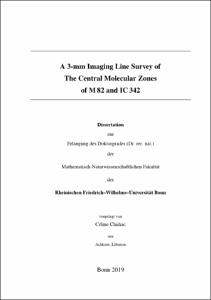A 3-mm Imaging Line Survey of the Central Molecular Zones of M 82 and IC 342

A 3-mm Imaging Line Survey of the Central Molecular Zones of M 82 and IC 342

| dc.contributor.advisor | Zensus, J. Anton | |
| dc.contributor.author | Chidiac, Céline | |
| dc.date.accessioned | 2020-07-07T12:22:21Z | |
| dc.date.available | 2020-07-07T12:22:21Z | |
| dc.date.issued | 07.07.2020 | |
| dc.identifier.uri | https://hdl.handle.net/20.500.11811/8441 | |
| dc.description.abstract | The central molecular zones of two nearby galaxies M 82 and IC 342 are among the most prominent extragalactic molecular sources in the northern hemisphere. While M 82 is a relatively small late type starburst galaxy, IC 342 is a spiral galaxy similar to the Milky Way in many respects, but seen face-on. While the two galaxies share many properties such as global molecular gas mass, H2 column densities, and density of bulk gas, they differ in their star formation rates. In order to investigate how the star formation rate depends on the physical environments, conditions, and chemistries, the molecular content of the central molecular zones of M 82 and IC 342 has been studied, and different environmental conditions, e.g. shocks, hot cores, photo-dissociation regions were traced. A spectral mapping survey targeting the central molecular zones of M 82 and IC 342 (with a spatial resolution of 43 and 50 pc for IC 342 and M 82 respectively), and covering almost the entire 3-mm range has been performed using the Plateau de Bure Interferometre, now known as NOrthern Extended Millimetre Array (NOEMA). This survey provides an inventory of the molecular content and distribution in the central molecular zones of these galaxies. Among the molecules observed are tracers of shocks, dense gas, and photodissociation regions, which in turn are tracers of ongoing high mass star formation. In M 82, 15 molecular species were detected, in addition to three radio Hα recombination lines. In IC 342, 22 molecular species were detected. Most notably, SiO and HNCO (both shock tracers), CH3CN, and CH3OH were detected in IC 342 but not in M 82. The only complex molecule detected in M 82 is CH3CCH, which is believed to be a tracer of photo-dissociative radiation. In general, the abundance of molecules relative to C18O are higher in M 82 than they are in IC 342. The column densities observed in this study were compared to chemical models in order to relate the physical and chemical conditions of the molecular clouds. The chemical models show that the central molecular zone in M 82 and IC 342 have a cosmic-ray ionisation rate 5000 times higher than the local standard value, with a visual extinction of around 50 mag. For a better understanding of the spatial distribution of the molecules, a principal component analysis has been applied to the data, thus associating, different chemical tracers with different physical locations in the galaxies. The principal component analysis showed a strong correlation between HCN and HCO+, and between CCH and HCN in M 82. In IC 342, a strong correlation between HCN and HCO+, and between C18O and 13CO was observed. Moreover, the principal component maps showed that in IC 342, dense gas traced by HCN and HCO+ is more concentrated in the centre of IC 342, while shocks (traced by HNCO) are more dominant on the outer sides of the central molecular zones of the galaxy. The results showed that in M 82, the gas is affected by photo-dissociation regions and emission from massive stars, as traced by Hα lines. The detection of N2H+ in M 82 indicates the presence of a quiescent gas with a visual extinction higher than 20 mag, that can act as gas reservoir and fuel future star formation. On the other hand, in IC 342, shocks (traced by SiO and HNCO) are dominating the heating processes, thus halting the star formation. | en |
| dc.language.iso | eng | |
| dc.rights | In Copyright | |
| dc.rights.uri | http://rightsstatements.org/vocab/InC/1.0/ | |
| dc.subject.ddc | 520 Astronomie, Kartografie | |
| dc.subject.ddc | 530 Physik | |
| dc.title | A 3-mm Imaging Line Survey of the Central Molecular Zones of M 82 and IC 342 | |
| dc.type | Dissertation oder Habilitation | |
| dc.publisher.name | Universitäts- und Landesbibliothek Bonn | |
| dc.publisher.location | Bonn | |
| dc.rights.accessRights | openAccess | |
| dc.identifier.urn | https://nbn-resolving.org/urn:nbn:de:hbz:5-58787 | |
| ulbbn.pubtype | Erstveröffentlichung | |
| ulbbnediss.affiliation.name | Rheinische Friedrich-Wilhelms-Universität Bonn | |
| ulbbnediss.affiliation.location | Bonn | |
| ulbbnediss.thesis.level | Dissertation | |
| ulbbnediss.dissID | 5878 | |
| ulbbnediss.date.accepted | 28.04.2020 | |
| ulbbnediss.institute | Angegliederte Institute, verbundene wissenschaftliche Einrichtungen : Max-Planck-Institut für Radioastronomie (MPIfR) | |
| ulbbnediss.fakultaet | Mathematisch-Naturwissenschaftliche Fakultät | |
| dc.contributor.coReferee | Bertoldi, Frank |
Dateien zu dieser Ressource
Das Dokument erscheint in:
-
E-Dissertationen (4442)




